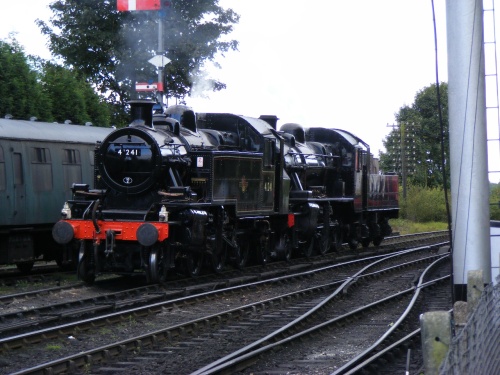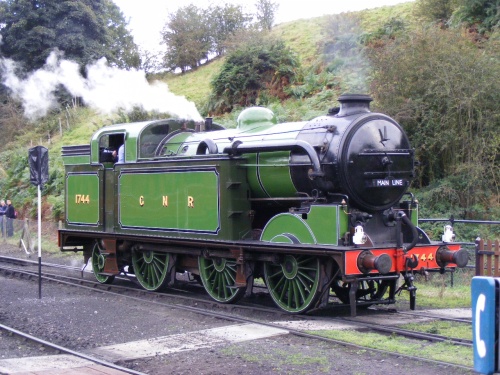 I’ve been familiar with this station since the late 1940s when I used to go to school in Lichfield by steam hauled train. In the early 1960s I started work in Walsall and used the train in the opposite direction, to Walsall, but by that time steam had virtually disappeared and diesel had taken over.
I’ve been familiar with this station since the late 1940s when I used to go to school in Lichfield by steam hauled train. In the early 1960s I started work in Walsall and used the train in the opposite direction, to Walsall, but by that time steam had virtually disappeared and diesel had taken over.
Looking in the other direction, towards Walsall, the second arch of the
bridge can be made out. This did indeed lead to the canal basins and the Wyrley And Essington canal, and sidings on both sides of the main line. This unusual picture shows some of the sidings, looking back towards Brownhills Station in the Lichfield direction. Goods were unloaded by the building on the left-hand side and delivered by Scammell Scarab hauled lorries.
This unusual picture shows some of the sidings, looking back towards Brownhills Station in the Lichfield direction. Goods were unloaded by the building on the left-hand side and delivered by Scammell Scarab hauled lorries. The exit from the goods yard was difficult enough in those days – at the junction of Pelsall Road and Chester Road, virtually on the corner. Just as well there was not much traffic about back then!
The exit from the goods yard was difficult enough in those days – at the junction of Pelsall Road and Chester Road, virtually on the corner. Just as well there was not much traffic about back then!

These maps shows the line to the canal basins, passing the bus garage on the way.

London & North-Western Railway Buses
On 1st October 1912 the London & North-Western Railway introduced a bus service between Brownhills, Norton Canes and Hednesford using two Milnes Daimler double-decker buses purchased second-hand 3 years previously from the Associated Omnibus Co., London.
The following year, on the 16th June, a variant of the above service began running via Chasetown and Chase Terrace and additional buses, double-decker Commers were sent to Brownhills.
Painted in standard coaching colours of chocolate and milk, buses carried the company name or initials on the front, back and sides of the top deck and displayed the company Coat of Arms on the sides of the lower deck.
The majority of the LNWR bus services in various parts of England and Wales were withdrawn on 17th April 1915, both Brownhills services included. The decision to withdraw services being brought about by the continued ‘call-up’ of staff for military service and the probability of buses being commandeered by the War Office.


 5764 leaving Bridgnorth
5764 leaving Bridgnorth



 The favourite on the day – 43106
The favourite on the day – 43106

 Ordered by Houghton Main Colliery Co.Ltd., Yorkshire on William Harrison’s behalf, the Colonel was probably delivered new to Brownhills.
Ordered by Houghton Main Colliery Co.Ltd., Yorkshire on William Harrison’s behalf, the Colonel was probably delivered new to Brownhills. Pictured at Granville Colliery, 12-6-1964
Pictured at Granville Colliery, 12-6-1964


 I’ve been familiar with this station since the late 1940s when I used to go to school in Lichfield by steam hauled train. In the early 1960s I started work in Walsall and used the train in the opposite direction, to Walsall, but by that time steam had virtually disappeared and diesel had taken over.
I’ve been familiar with this station since the late 1940s when I used to go to school in Lichfield by steam hauled train. In the early 1960s I started work in Walsall and used the train in the opposite direction, to Walsall, but by that time steam had virtually disappeared and diesel had taken over.
 This unusual picture shows some of the sidings, looking back towards Brownhills Station in the Lichfield direction. Goods were unloaded by the building on the left-hand side and delivered by Scammell Scarab hauled lorries.
This unusual picture shows some of the sidings, looking back towards Brownhills Station in the Lichfield direction. Goods were unloaded by the building on the left-hand side and delivered by Scammell Scarab hauled lorries. The exit from the goods yard was difficult enough in those days – at the junction of Pelsall Road and Chester Road, virtually on the corner. Just as well there was not much traffic about back then!
The exit from the goods yard was difficult enough in those days – at the junction of Pelsall Road and Chester Road, virtually on the corner. Just as well there was not much traffic about back then!



 The second day highlight in the heritage centre was this six coupled diesel loco – it’s just a pity more people didn’t see it. As I said yesterday, our visitors don’t like walking round to the back door. There were times when there was no loco movement in the vicinity and it would have been safe to cross – if only we had a Station Master on duty to control the crossing. It would surely be a quite simple task for someone with an understanding of the timetable. To continue the now regular moan about station staff, it does seem absolutely ridiculous that the railway has a Gala, with a fairly complex timetable, and no-one on duty on the platform, in uniform to help our paying passengers. Earlier in the year, were five people not appointed Station Masters – what has happened to them?
The second day highlight in the heritage centre was this six coupled diesel loco – it’s just a pity more people didn’t see it. As I said yesterday, our visitors don’t like walking round to the back door. There were times when there was no loco movement in the vicinity and it would have been safe to cross – if only we had a Station Master on duty to control the crossing. It would surely be a quite simple task for someone with an understanding of the timetable. To continue the now regular moan about station staff, it does seem absolutely ridiculous that the railway has a Gala, with a fairly complex timetable, and no-one on duty on the platform, in uniform to help our paying passengers. Earlier in the year, were five people not appointed Station Masters – what has happened to them? But that still leaves four!
But that still leaves four!

 The narrow gauge ran demonstration trains for a while, but, with no passenger facility, didn’t seem to generate much interest among the public on this occasion.
The narrow gauge ran demonstration trains for a while, but, with no passenger facility, didn’t seem to generate much interest among the public on this occasion. I hope that passenger figures prove me wrong as to the overall ‘feel’ of the Gala, but after the great success of the 50th Anniversary bash it felt a little flat.
I hope that passenger figures prove me wrong as to the overall ‘feel’ of the Gala, but after the great success of the 50th Anniversary bash it felt a little flat. It’s a frame-up!!
It’s a frame-up!! Getting steam up!
Getting steam up! For the first time for a number of years we had the Western Re-enactment Group showing what they could do. They certainly enjoy themselves and try to ensure that spectators enjoy it too! Everyone knew that they were there – those guns had no silencers!!
For the first time for a number of years we had the Western Re-enactment Group showing what they could do. They certainly enjoy themselves and try to ensure that spectators enjoy it too! Everyone knew that they were there – those guns had no silencers!! The only down-side as far as I could see was the number of visitors to the museum. Whenever our visitors have to walk around the platform instead of entering the Heritage Centre via the crossing, it seems that they just won’t do it – numbers today were well down on recent weeks, enthusiasts come to see us but not ordinary passengers. Perhaps it will be better tomorrow if the narrow gauge is running demonstration trains.
The only down-side as far as I could see was the number of visitors to the museum. Whenever our visitors have to walk around the platform instead of entering the Heritage Centre via the crossing, it seems that they just won’t do it – numbers today were well down on recent weeks, enthusiasts come to see us but not ordinary passengers. Perhaps it will be better tomorrow if the narrow gauge is running demonstration trains. Bearing in mind that Sundays are nearly always better-attended than Saturdays, and the weather forecast is still exceptional, we should be very busy tomorrow.
Bearing in mind that Sundays are nearly always better-attended than Saturdays, and the weather forecast is still exceptional, we should be very busy tomorrow.

 MS & L Coach at Easingwold with J72 Class loco, 1947/48
MS & L Coach at Easingwold with J72 Class loco, 1947/48